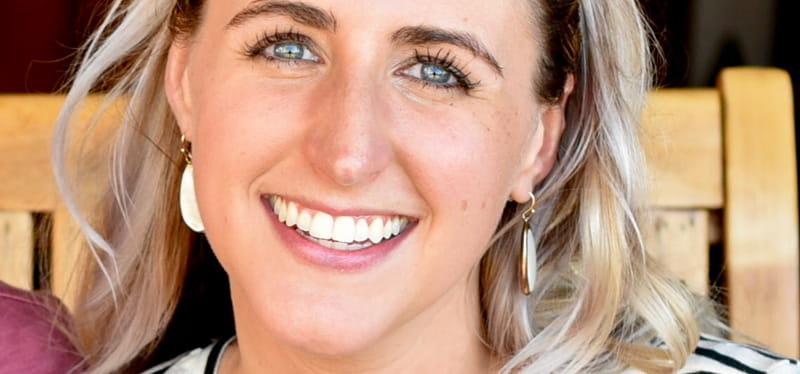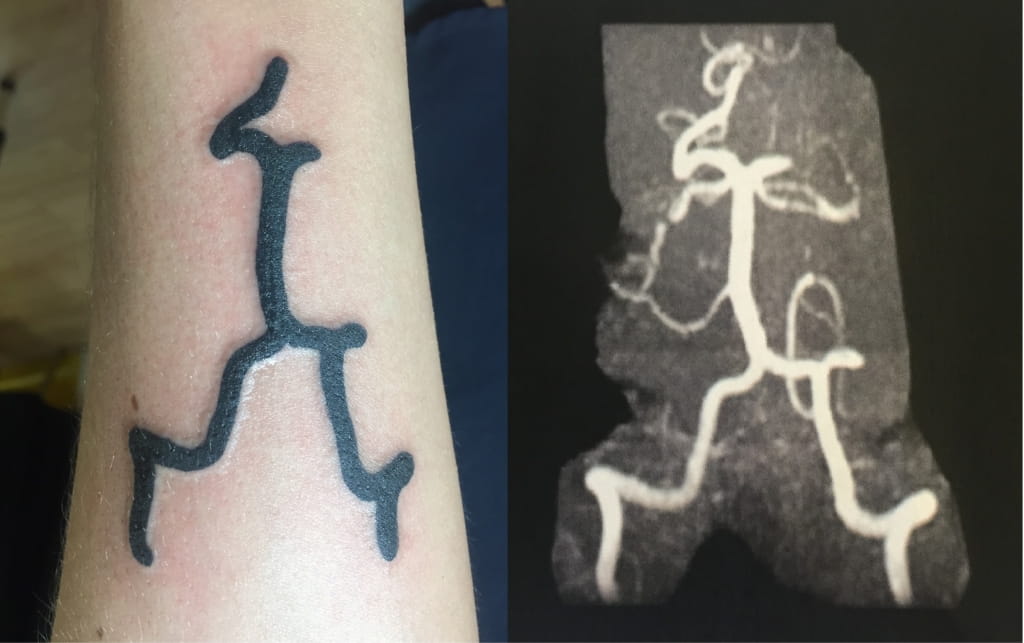Tattoo is a unique conversation-starter for this stroke survivor
By American Heart Association News

Scars are a natural sign of healing, but not every physical trauma leaves a visible reminder. The only outward sign that 27-year-old Skylar Doerwaldt is a stroke survivor is of her choosing: a tattoo on her left forearm.
The dark, jagged lines represent the arteries in her neck. It’s a copy of the magnetic resonance angiography scan taken when she had an ischemic stroke three years ago.
“I’ve always wanted a tattoo, but I wanted it to mean something,” Doerwaldt said. “This is unique, and it opens up the door for conversation.”

In most ways, it was a Tuesday like any other. After a normal workday in Charlottesville, Virginia, she met a friend for dinner at a popular burger joint. They wound up back at Doerwaldt’s apartment.
That’s when she felt something in her head go pop.
“And the room started spinning,” she said.
To combat the intense vertigo, Doerwaldt laid on the couch. Once she started feeling better, she sat up. Her friend said the left side of Doerwaldt’s face was drooping. Frightened, she fumbled to call her mother. She could barely see the screen.
Trying to leave a voice mail, she couldn’t understand the garbled words coming out of her own mouth.
“There was a weird disconnect in my brain,” Doerwaldt said.
FAST is the acronym to help people remember the warning signs of a stroke. If you see someone with (F)ace drooping, (A)rm weakness or (S)peech difficulty, then it’s (T)ime to call 911.
Fortunately, Doerwaldt’s friend recognized that she likely was having a stroke. Instead of calling for an ambulance, however, he raced her to an emergency room.
When they reached the hospital, Doerwaldt couldn’t see out of her left eye. She couldn’t feel anything on her left side. Her left leg dragged behind her as she walked.
“It felt like I had been shot in the head,” Doerwaldt said.
A CT angiography confirmed what doctors suspected: a blood clot in her brain. So they administered alteplase, an FDA-approved treatment for ischemic strokes, which means they occur because of an obstruction within a blood vessel that supplies blood to the brain. Administered by IV, alteplase works by dissolving the clot and improving blood flow to the part of the brain deprived of blood flow. The drug improves outcomes in patients who receive it, but timing is crucial.
“For every one minute that goes by that the brain isn’t getting oxygen, the brain loses about 2 million cells,” said Dr. Andrew Southerland, a neurologist at the University of Virginia Health System who treated Doerwaldt.
Medical advances like alteplase have helped to reduce the percentage of stroke deaths, according to the American Heart Association. Doerwaldt’s treatment is a good example.
Within 48 hours of receiving the treatment, she went home.
The source of Doerwaldt’s stroke was a spontaneous cervical artery dissection. In layman’s terms, a large artery in her neck tore open. That’s what caused the clot that temporarily blocked blood from reaching her brain.
“Amazingly, with appropriate time and medical management, most people with cervical artery dissection heal on their own,” Southerland said. “When we feel comfortable that it’s healing, we tell them to resume their normal activity and enjoy life.”
In the three years since her frightful experience, Doerwaldt has experienced weakness in her left side, side effects from medication and a small blind spot in her vision. But she continues to improve.
At first, she couldn’t balance on a Pilates ball during her workouts; now she does so effortlessly, using it for squats, arm curls and more.
In addition to working as a manager for a large residential home builder, Doerwaldt enjoys spending time with friends and volunteering for charities. She works closely with Southerland on Spokes for Strokes, an annual “spin-a-thon” to raise money for CADISP, an international collaboration between researchers studying strokes in young people.
Last year, Southerland and Doerwaldt also served together on the auction committee for the AHA's Heart Ball in Charlottesville. The work is important to Doerwaldt for the same reason that she decided to get the tattoo.
“Nobody looks at a woman in her 20s and thinks she could be a stroke survivor, and it’s important to raise awareness that it can happen to anybody,” Doerwaldt said.
The graphic image on her left forearm also serves another important purpose.
“I look at it as a reminder to not take things for granted,” she said, “and to live every day to its fullest.”
Stories From the Heart chronicles the inspiring journeys of heart disease and stroke survivors, caregivers and advocates.
If you have questions or comments about this story, please email [email protected].




